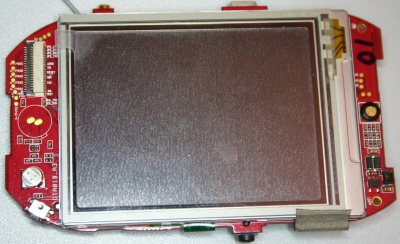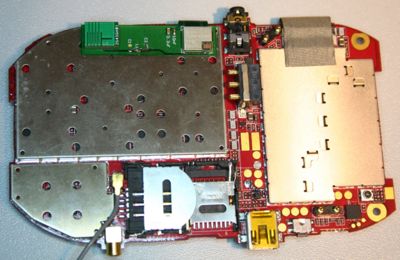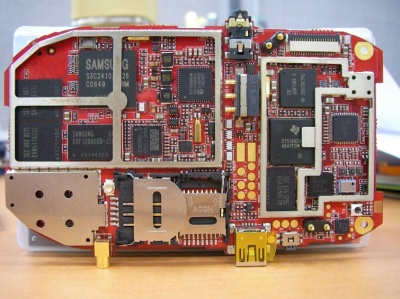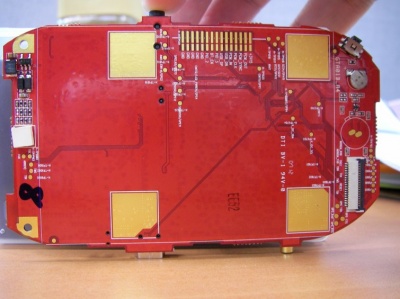Neo1973 Hardware/es
From Openmoko
Openmoko Es un conjuto de aplicaciones (programas) que se encuentran en un nivel superior sobre una determinada plataforma (sin importar cual sea).El sistema físico (Hardware)del Neo1973 es la primera plataforma que toma la ventaja de usar la distribución Openmoko . Puede encontar las epecificaciones del Neo1973 leyendos estas páginas de introducción y las páginas especifícas para el Neo1973 descritas en la parte de abajo.
Experiencias de los usuarios con el hardware de Fase 0
Dimensiones físicas
- 120,7 x 62 x 18,5 mm (4,75 x 2,44 x 0,728 inch)
- 184 +/- 5 g (6,5 ounces)
Componentes principales
Procesador
El «cerebro» del sistema (CPU) Neo1973 es un Samsung S3C2410AL-26 (Con una frecuencia máxima de 266 MHz)
- Página del procesador: S3C2410.htm
- Manual de usuario: 2410UserManual.pdf
- Archivo BSDL: S3C2410_BGA_BSDLJTAGFILE.bsd
- Descripción de terminales (GPIO Assignments): https://svn.openmoko.org/trunk/doc/hardware/GTA01Bv3/gpio.txt
Memoria Flash
64MB Samsung NAND flash (K9F1208U0B) unida al controlador NAND S3C2410.
- Página de la memoria: K9F1208U0B.htm
- Hojas de datos: ds_k9f1208x0b_rev03.pdf
- Conectado a: Controlador NAND S3C2410.
Ésta es la única memoria flash del dispositivo. El procesador S3C2410 se inicia directamente desde la nand usando el S3C2410 Steppingstone.
Sólo usamos programas libres (free software) y sistemas de archivos no propietarios para la flash. Para una descripción más detallada sobre cómo se ha usado, por favor diríjase a:NAND bad blocks
Memoria RAM
128MB SDRAM (2x Samsung K4M511633C) unida al controlador SDRAM S3C2410.
- Página del producto: K4M511633C.htm
- Hojas de especificaciones: ds_k4m511633c.pdf
- Conectado a: S3C2410
Sistema de comunicación GSM/GPRS
El sistema de comunicación (módem) GSM/GPRS está basado en el sistema Calypso de Texas Instruments.
- Conectado a: S3C2410 UART1 (full-uart, RxD, TxD, CTS, RTS), /dev/ttySAC0 en el espacio de usuario
- Controlador PM: [1]
- Jack de antena GSM/GPRS accesible (al retirar la tapa de la batería)
Circuito Integrado de Banda Base Digital CALYPSO
Lamentamos no poder suministrar muchos detalles del Chipset GSM debido a exigencias estrictas establecidas en los Acuerdos de Confidencialidad (Non Disclosure Agreement, NDA). No obstante, el acceso a este nivel de información puede ser innecesario, puesto que este circuito integrado se conecta con el S3C2410 por medio de una conexión serie serie -UART- estándar. Esta interfaz está basada en siguientes normas: GSM 07.05, GSM 07.10
Circuito Integrado de Banda Base Analógica TWL3014
Página del producto: TWL3014
Emisor-receptor RF TRF6151
Página del producto: TRF6151
Soporta cuatro bandas RF
Soporta GPRS Clases 12/CS4
AGPS
Hammerhead PMB 2520 AGPS de Global Locate.
- Página del producto: Hammerhead
- Conectado a: S3C2410 UART2 (full-uart, RxD, TxD, CTS, RTS) /dev/ttySAC1 in userspace
- Controlador: Implemented as plugin for the gpsd daemon (gpsd)
- Controlador PM: https://svn.openmoko.org/trunk/src/target/kernel/patches/gta01-power_control.patch
- Conector de antena GPS accesible externamente del tipo MMCX
No habrá un driver funcional hasta al menos mitad de Abril.
microSD-Card
El Neo1973 dispone de una microSD, también conocida como ranura Transflash. Deberia también soportar SDHC, pero esta funcion no ha sido verificada. Si funciona, las tarjetas >2G deberian funcionar sin problemas. Como no existen tarjetas microSD sobre 2G por el momento, no ha sido posible realizar las verificaciones.
MicroSD slot is under battery.
- Connected to: S3C2410 MMC/SD controller
- Driver: https://svn.openmoko.org/trunk/src/target/kernel/patches/s3c_mci.patch
- Supported microSD cards
- Specifications: SD Simplified Specification, MMC (partial), MMC (product manual)
Pantalla de cristal líquido. (LCD)-(LCM)
Tiene un tamaño de 2,8 púlgadas -diagonal- (1,7" x 2,27" - 43mm x 58mm) con un tamaño de 480x640 pixeles. Usa el los módulos TD028TTEC1 y el Toshiba JBT6K74 TFT como controlador de la pantalla (LCD).
- Página: Activer-Matrix-VGA.htm
- Controladores: https://svn.openmoko.org/trunk/src/target/kernel/patches/gta01-jbt6k74.patch
- Controlador de iluminación (backlight): https://svn.openmoko.org/trunk/src/target/kernel/patches/gta01-backlight.patch
- En interfaz con: S3C2410 controlador y S3C2410 SPI -Serial perihal intrerface- primer canal
Pantalla táctil. (Touch Screen)
- EL integrado:S3C2410 TS.
- El controlador: https://svn.openmoko.org/trunk/src/target/kernel/patches/s3c2410_touchscreen.patch
Aparentemente es similar a: ebay
Bluetooth
Delta DFBM-CS320 Class2 Module, CSR BlueCore4
- Hoja de datos: 2.DFBM-CS320.pdf
- Hoja de datos de CSR : CS-101564-DSP10 BlueCore4-ROM Product Data Sheet.pdf
- Controlador: Stock Linux Kernel BlueZ
- En interfaz con: S3C2410 USB Host controller (OHCI)
- Controlador de energía (PM) : https://svn.openmoko.org/trunk/src/target/kernel/patches/gta01-power_control.patch
Vibrador
- Controlador: https://svn.openmoko.org/trunk/src/target/kernel/patches/gta01-vibrator.patch
- Conectado a: S3C2410 sistema general de entradas y salidas :) (GPIO).
Huesped USB
El controlador USB está incluído en S3C2410
- Controlador: Núcleo de linux(Kernel) ohci_hcd
USB Device
The USB Device controller is inside the S3C2410
- Driver: https://svn.openmoko.org/trunk/src/target/kernel/patches/s3c2410_udc.patch
- Please see USB Product IDs on information about which Vendor/Product IDs we use
- 1200mAh lithium battery charges when connected to powered host.
- Mini-AB connector similar to this one.
Audio
Puede ver: Neo1973 Audio Subsystem
Protocolo (codec) Wolfson
There's a WM8753 Wolfson Microelectronics CODEC (This is not a 'smart' codec that can interpret MP3/... it is a simple dumb 'sound card'.
- Product Homepage: http://www.wolfsonmicro.com/products/WM8753/
- Data Sheet: WM8753.pdf
- Connected to: S3C2410 IIS interface (PCM data), S3C2410 I2C (Control)
- Driver: https://svn.openmoko.org/trunk/src/target/kernel/patches/asoc.patch
Aplificador Estéreo -bifónico-
There's a National Semiconductor LM4857 Stereo Amplifier at the analog audio output of the WM8753
- Product Homepage: LM4857.html
- Data Sheet: LM4857.pdf
- Connects to: S3C2410 I2C (Control)
Audífonos (auriculares) analógicos
There's a four-ring 2.5mm stereo jack which provides connectivity to old-fashioned wired headsets.
The headsets used by Motorola smartphones (A780,A1200, ...) and the V-360 have a compatible configuration.
Bluetooth Headset
This one is wired via PCM bus from the CSR Bluetooth chip to the Wolfson codec.
Control de energía
El integrado PCF50606 de Philips es usado para tal fin.
- Hoja de datos: PCF50606/605
- Manual de usuario: pcf50606.pdf
- Coenctado a: S3C2410 vía I2C, la dirección del cliente es 0x08.
- Fuientes del controlador: https://svn.openmoko.org/trunk/src/target/kernel/patches/gta01-pcf50606.patch
Pilas (batería o celdas de energía)
La celda de energía Neo1973 es compatible con la betría BL5C de Nokia. De acuerdo a verLista . Foto de la pila, dentro del Neo1973.
Botones
El Neo1973 posee dos botones:
Historia
GTA01
El primer prototipo, el más simple y sin «bluetooth».
GTA01v3
First generation of prototypes that was given to internal Openmoko software developers.
Unfortunately not useful at all due to non-working touchscreen.
- ATAG_REVISION: 0x0000130
GTA01v4
Second generation of prototypes that was given to Harald + Mickey.
Unfortunately still not useful due to half-working touchscreen.
- ATAG_REVISION: 0x00000140
GTA01B
This is the bluetooth-enabled fork of GTA01
GTA01Bv2
This is the first produced version of the bluetooth-enabled version.
- ATAG_REVISION: 0x00000220
GTA01Bv3
This is the second produced version of the bluetooth-enabled version. It contains mainly GPS-related fixes.
- ATAG_REVISION: 0x00000230
This is the version that is shipped in Phase 0
GTA01Bv3 Errata
PMU unable to resume from suspend
Due to use of wrong GPIO/EINT pin, the PMU cannot wake-up the phone after suspend. This means, specifically, the following events can not bring the phone back from suspend-to-ram:
- PMU RTC Alarm
- Power button press
- Charger events (charger insertion/removal/error)
- Low battery
Stand-by time extremely low
This is due to a design bug resulting in at least 30mA additional standby current, since we cannot properly switch off the power supply to the S3C2410 PLL's. There is nothing we can do to change this with post-production fixes. GTA01Bv4 will address this issue.
GSM doesn't resume phone from suspend
The GSM modem currently doesn't signalize a wakeup interrupt to the S3C2410 in case there's some noteworthy event, such as incoming call, loss of network, incoming SMS or the like.
This is a serious issue, but can be fixed with a GSM Modem Firmware update.
GSM Sidetone too loud
The local feedback sidetone (see [2]) is too loud. This will be addressed in a GSM firmware update
Bad block
Due to an error in the production process, the factory-programmed NAND bad block information has been lost. This means that some blocks in the flash will wear out rapidly, which might become as bad as rendering the device unusable.
GTA01Bv4
This is the version that will be shipped in Phase 1
Vistas
Esta es las vista del impreso GTA01Bv4.
Changes from GTA01Bv3
- Fix all Errata items from GTA01Bv3
- Add I2C, SPI and one irq and wakeup capable GPIO pin to debug port plus have test pads for all these signals (for soldering wires directly on the pcb)
- Fix a number of production related details and minor hardware details that are not user-visible
Distinguishing hardware revisions
Inside the Bootloader
Every hardware revision has its own u-boot image type. Thus, the bootloader has the revision hard-coded. The hardware revision is passed on to the kernel via the ATAG mechanism (ATAG_REVISION)
Inside the Kernel
The kernel receives the ATAG_REVISION during bootup, and saves its contents in the "system_rev" global variable.
From Userspace
The kernel exports the system_rev variable in /proc/cpuinfo as "Revision :" line.
Approval
| Languages: |
English • العربية • Български • Česky • Dansk • Deutsch • Esperanto • Eesti • Español • فارسی • Suomi • Français • עברית • Magyar • Italiano • 한국어 • Nederlands • Norsk (bokmål) • Polski • Português • Română • Русский • Svenska • Slovenčina • Українська • 中文(中国大陆) • 中文(台灣) • Euskara • Català |




